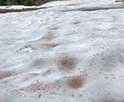Giant Waves: Identifying Earth's Regions Vulnerable to Mega Tsunamis
Mega Tsunamis Over 300 Meters: Which Areas on Earth Could Be Affected?
Reading time : 1 minute,
Discovery Chepe Id-708-ECO
Published in
05-19-2025

While regular tsunamis are already among the most destructive natural disasters, mega tsunamis?with waves surpassing 300 meters (almost 1,000 feet)?could cause devastation on an unimaginable scale. These colossal walls of water are rare but possible, and scientists have identified several regions where they could strike if the right geological events were to occur.
What causes a mega tsunami?
Unlike traditional tsunamis caused by earthquakes under the ocean, mega tsunamis are typically triggered by massive landslides, volcanic collapses, or asteroid impacts. These events displace a tremendous amount of water almost instantly, creating a wave much taller and more forceful than typical seismic tsunamis.
La Palma, Canary Islands
One of the most discussed potential sources of a future mega tsunami is the volcanic island of La Palma. Scientists warn that a future eruption could cause a large portion of the island's flank to collapse into the Atlantic Ocean. This event might send a wave over 300 meters high toward the east coast of the Americas. According to the Scientific American, the tsunami could reach the coasts of the United States, the Caribbean, and South America within hours.
Alaska, USA
In 1958, a landslide in Lituya Bay, Alaska, caused a wave that reached an astonishing 524 meters high. Although the geography of the bay prevented the wave from traveling far, a similar event in a more open setting could unleash a true mega tsunami. Alaska remains one of the most closely monitored zones for such events due to its steep coastal cliffs and tectonic activity.
Hawaiian Islands
Hawaii's volcanic islands are also susceptible. Geological evidence suggests that huge portions of these islands have collapsed in the past, causing enormous tsunamis across the Pacific. A future collapse, especially from the Big Island's unstable slopes, could send waves racing toward the west coasts of North and South America, as well as Asia. Learn more from this article by the Live Science team.

Understanding Mega Tsunamis and Their Global Threat
b>Norwegian Sea and North Atlantic
The Storegga Slide off the coast of Norway is a historical example of an underwater landslide that generated a large tsunami. A repeat of such an event could send waves crashing into the UK, Iceland, and parts of Northern Europe. Although it happened over 8,000 years ago, scientists believe similar landslides could happen again due to climate-induced changes in ocean sediments.
Indonesia and Southeast Asia
Indonesia, located in the Pacific Ring of Fire, is no stranger to tsunamis. A large landslide or volcanic eruption -such as from Mount Krakatoa- could trigger a wave over 300 meters in height. With densely populated coastlines, a mega tsunami here would result in catastrophic loss of life and infrastructure.
How to prepare for mega tsunamis
While the risk of mega tsunamis is extremely low compared to standard tsunamis, preparation is still vital. Authorities and scientists continue to study geological formations, monitor volcanic activity, and create early warning systems. Coastal residents in high-risk areas should familiarize themselves with evacuation plans and stay informed through official sources.
Final thoughts
Mega tsunamis may seem like the stuff of disaster movies, but geological evidence and computer models show that they are a real threat in specific regions of the world. While we cannot prevent these cataclysmic events, understanding where they might happen and how to respond can make the difference between survival and tragedy.
For more in-depth research and real-time data, visit the U.S. Geological Survey or the NOAA Tsunami Hazard Program.
See Also
Discovery Chepe
Most read...















